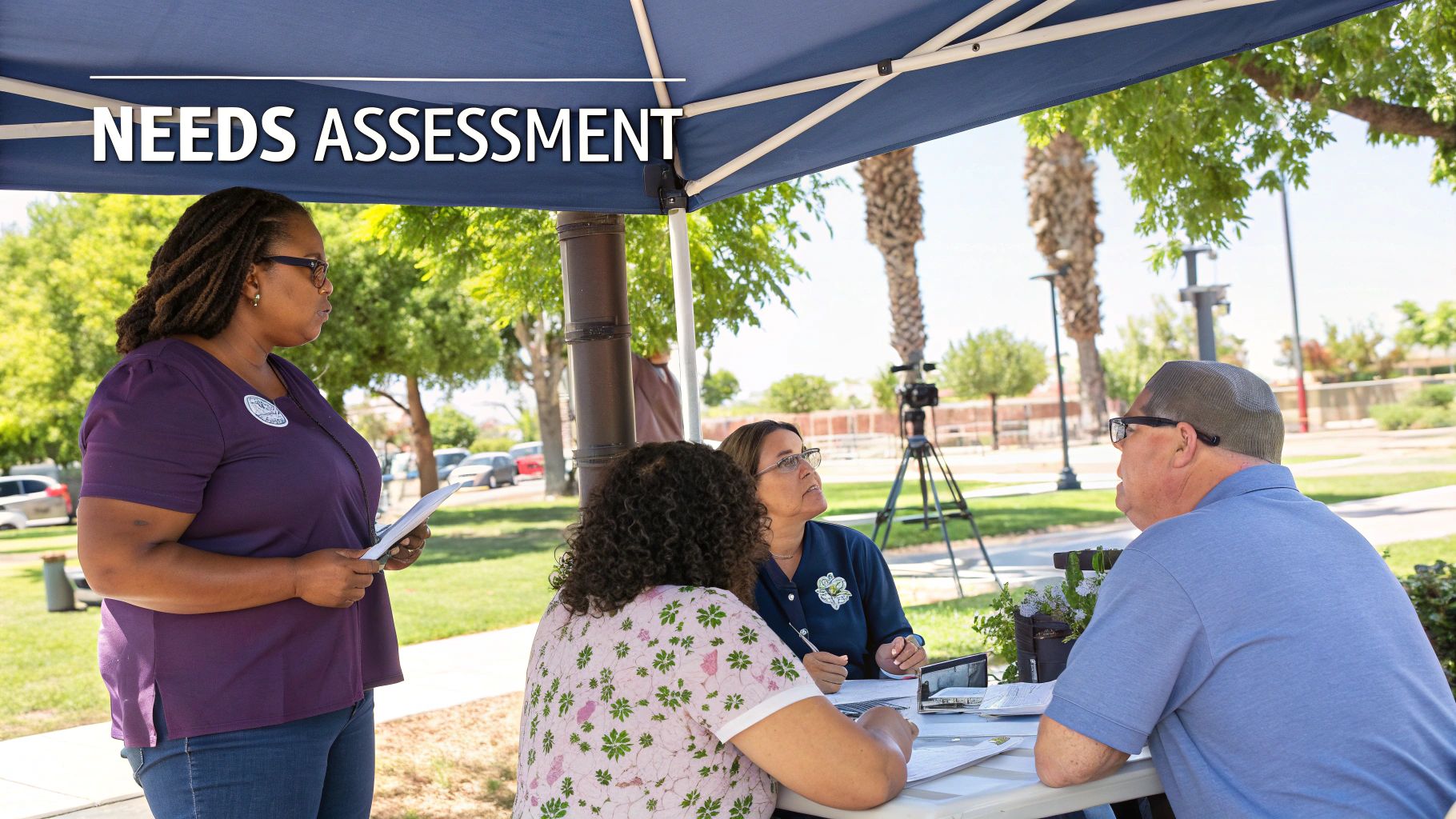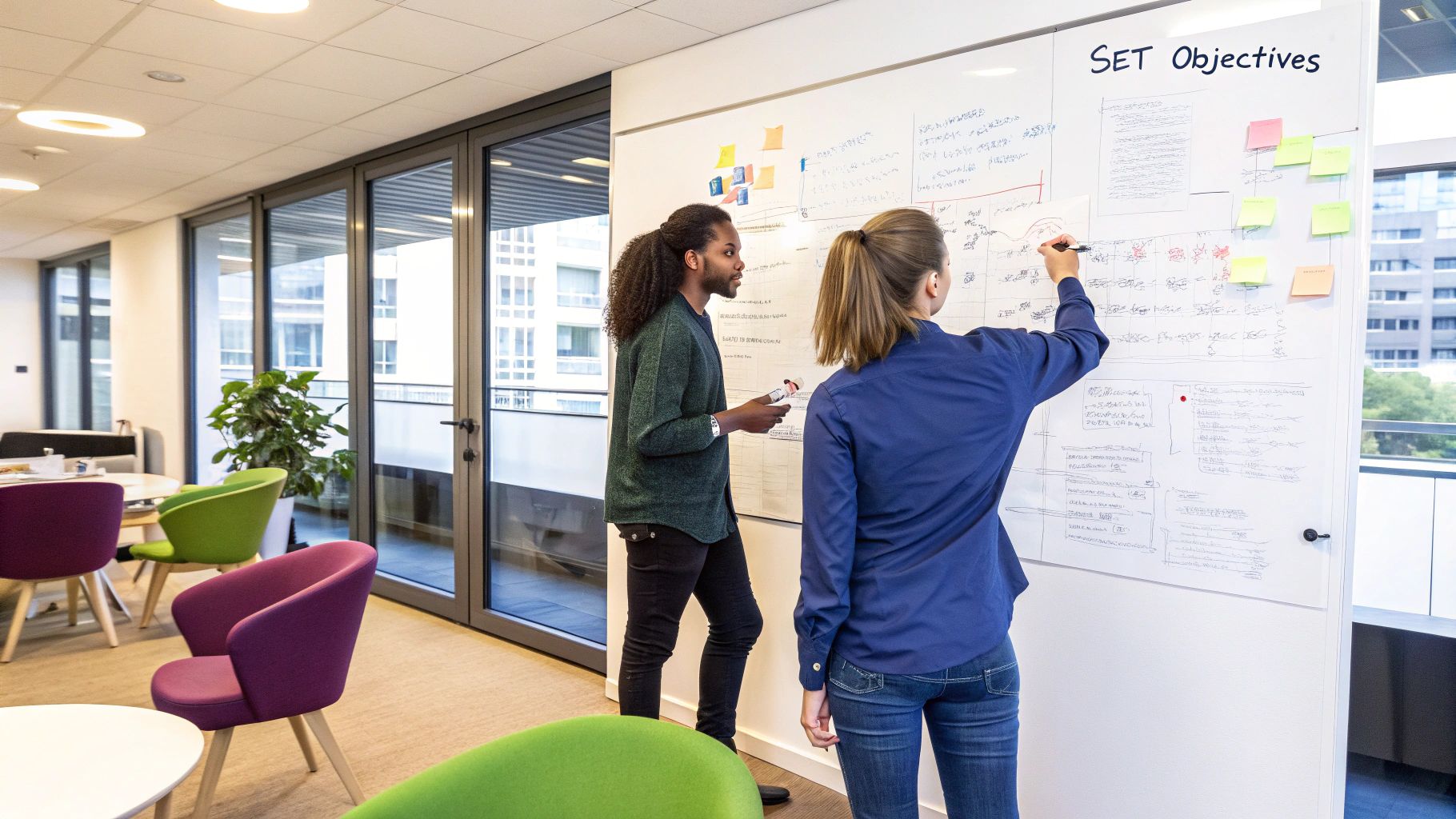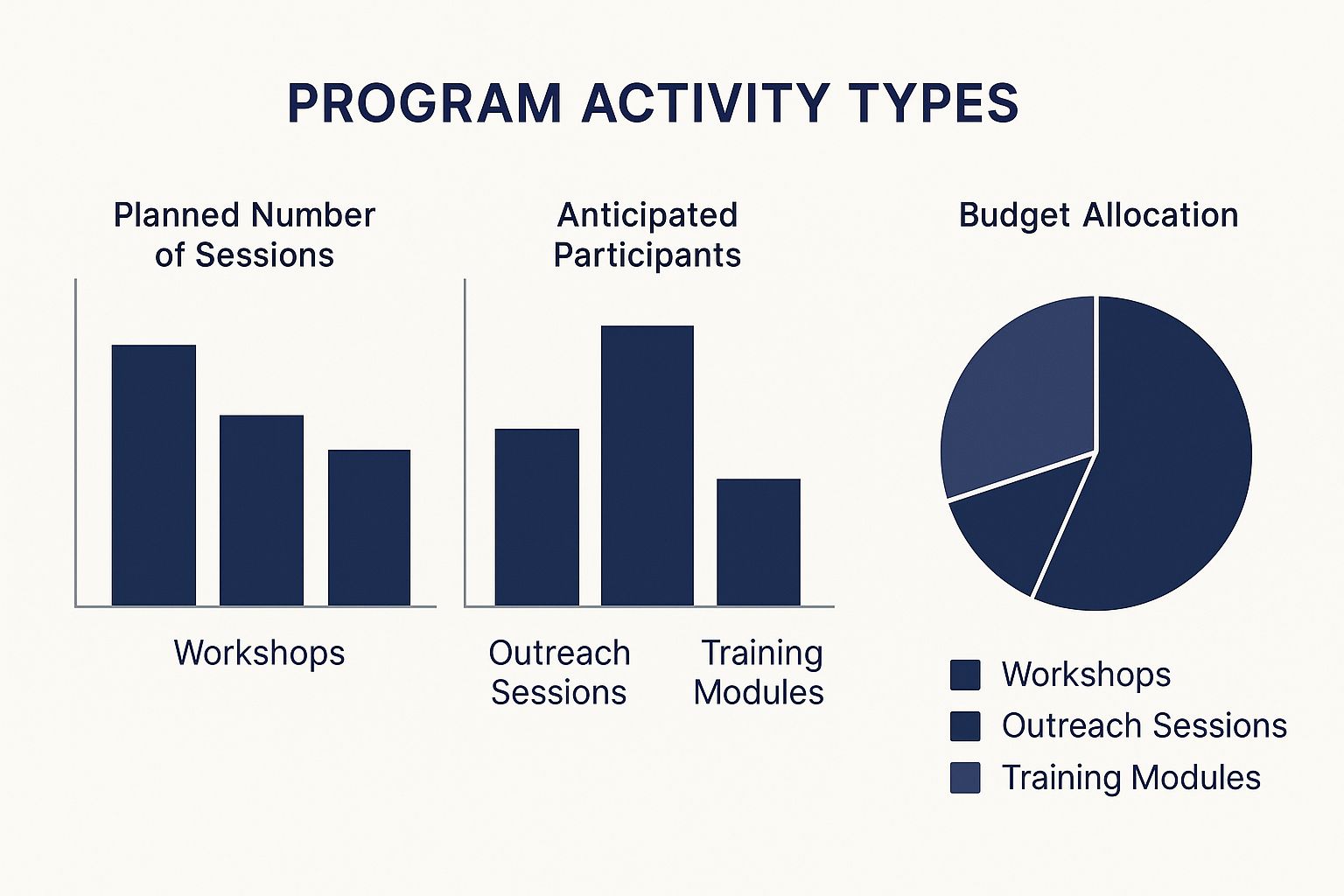
When you're running a nonprofit, program planning is more than just an administrative box to check. It's the thoughtful, structured process of bringing your mission to life—from pinpointing a real community need and setting clear goals to lining up your resources and, most importantly, proving your work makes a difference.
Why Effective Program Planning Matters for Nonprofits
Let's be real for a moment. The nonprofit world isn't what it used to be. Good intentions alone don't cut it anymore. Donors want to see concrete results, the problems we're tackling are getting more complex, and it often feels like the funding pie is shrinking. This is where solid nonprofit program planning shifts from a "nice-to-have" to a must-have for survival and growth.
Without a plan, it’s easy to get caught in a reactive loop—lurching from one crisis to the next instead of strategically building toward your vision. A well-thought-out program plan flips that script. It’s the roadmap that turns your organization from reactive to proactive, ensuring every task your team tackles is a deliberate step toward achieving your long-term goals.
Navigating a Crowded Field
The nonprofit sector has exploded in recent years. This growth has created a much more competitive space for both funding and public attention. There are now over 10 million nonprofit organizations around the globe, with more than 1.8 million right here in the U.S. That kind of expansion means you have to work smarter to demonstrate your unique value. For a deeper dive into these trends, you can explore detailed statistics on nonprofit growth on cazoomi.com.
While charitable giving hit a massive $520 billion in 2022, the sheer number of organizations vying for a piece of that pie is staggering. This is where your program plan becomes your secret weapon in fundraising. It gives you a compelling, evidence-backed story to tell, showing exactly what problem you're solving and why your solution deserves support.
From Doing Good to Proving Impact
Let’s clear something up: effective program planning isn’t about creating rigid, bureaucratic red tape that kills creativity. It's about building a strong, logical framework for everything you do. It’s the process that forces you to ask the tough questions before you sink precious time, money, and energy into an idea.
The real magic of program planning is the clarity it brings. It transforms a passionate concept into a workable, measurable, and fundable program. Think of it as the bridge connecting your mission statement to the real-world change you want to see.
When you have that strategic clarity, amazing things start to happen:
- You use resources intelligently. A plan makes sure every dollar spent, every staff hour logged, and every volunteer effort is aimed directly at activities that move the needle.
- You build trust and credibility. A well-documented plan shows funders, board members, and community partners that you’re professional, strategic, and accountable.
- You make better decisions under pressure. When unexpected hurdles or opportunities pop up, your plan is the anchor that helps your team make choices aligned with your ultimate purpose.
At the end of the day, this process lays the groundwork for everything else. It’s how you move beyond simply 'doing good' and start proving your impact with data that tells a powerful story. This guide will walk you through the practical steps to build that foundation.
Building Your Strategic Foundation

Before a single dollar is spent or one beneficiary is served, the most successful nonprofit programs start with a rock-solid strategic foundation. This is the blueprinting phase, and honestly, it's what separates programs that create real, lasting change from those that just fizzle out. Effective nonprofit program planning doesn't begin with a solution you've already dreamed up; it starts with a deep, humble understanding of the problem you're trying to solve.
The cornerstone of this entire process is a thorough needs assessment. I can't stress this enough. This isn't about guessing what your community needs. It's about systematically uncovering the genuine, often hidden, challenges they face. It means stepping outside your own organizational bubble and truly listening.
Conducting an Authentic Needs Assessment
An authentic needs assessment moves way beyond assumptions. Think of it as investigative work, gathering real-world data and, just as importantly, stories directly from the people you hope to serve. If you skip this, you risk building a beautiful program that solves a problem nobody actually has.
To get the full picture, you'll want to use a few different methods:
- Community Surveys: These are great for gathering quantitative data on the scale of the need.
- Focus Groups: Nothing beats getting a small group of community members in a room to explore their experiences. The qualitative insights you get here are pure gold.
- Stakeholder Interviews: Talk to community leaders, staff at partner organizations, and local officials. They see the landscape from a different angle and can provide crucial context.
- Direct Observation: Simply spend time in the community. Be present. Watch and listen. You'll notice things that a survey could never capture.
This process ensures your program is grounded in reality. I once saw a nonprofit that wanted to tackle food insecurity, assuming the issue was just a lack of food. After a proper needs assessment, they discovered the real barriers were a lack of transportation to grocery stores and a shortage of culturally appropriate food. That insight completely reshaped their program from a simple food pantry to a mobile market and a community garden initiative.
Assembling Your Program Vision and Mission
Once you have a crystal-clear understanding of the need, you can start crafting your program's guiding statements. These aren't just fluffy sentences to stick on your website; they are the North Star for every single decision you'll make moving forward.
Your program vision is the big-picture, aspirational change you want to see in the world. It answers the question, "If we succeed beyond our wildest dreams, what will be different?" It should be inspiring and maybe even a little audacious.
Your program mission, on the other hand, is much more grounded. It defines what your program will do, who it will serve, and why. Keep it clear, concise, and directly tied to your organization's overarching mission.
A powerful program mission acts as a filter. When a new opportunity or shiny new idea pops up, you can ask, "Does this actually align with our mission?" If the answer is no, it gives you the clarity to stay focused and avoid mission creep.
This foundational work also means defining your core values—the principles that guide how your team shows up and makes decisions. Strong financial stewardship is a huge part of this, making sure your vision is backed by a sustainable plan. To see what this looks like in practice, you might find our case study on nonprofit financial management insightful.
Embracing an Adaptive Strategy
The whole game of strategic planning has changed. Gone are the days of creating a rigid five-year plan that's obsolete by year two. Today's world demands a more flexible approach—a long-term vision that can adapt on the fly.
Many leading organizations are now crafting ambitious 30-year visions, like the Missouri Foundation for Health's goal to eliminate deep-seated health inequities, while using quarterly check-ins to adjust their tactics. This gives them both a grand ambition to strive for and the agility to navigate a constantly changing environment.
For many organizations, especially faith-based ones, this foundation must also include the safety and well-being of their community. For example, creating a comprehensive church safety plan is a critical piece of strategic planning that ensures the organization can fulfill its mission in a secure environment. This kind of foresight is what builds a truly resilient organization.
When you combine a deep needs assessment with a clear mission and an adaptive strategy, you build a foundation strong enough to support real, lasting impact.
Designing Your Program for Maximum Impact

Alright, this is where the rubber meets the road. You’ve done the research and listened to your community; now it's time to turn that insight into a real, working program. The goal here is to build a logical bridge that connects the resources you have to the change you want to create.
Think of it as building a program that’s not just effective in the field but also simple to explain and justify to funders. When someone asks how your program works, you should have a clear, compelling story to tell.
A fantastic tool I've used for years to do this is a logic model, sometimes called a theory of change. Don't get tripped up by the name. It’s really just a simple visual map that tells your program's story from start to finish. It answers the fundamental question: "How, exactly, will our actions lead to the results we're aiming for?"
This framework helps you organize your thinking into clear, connected pieces.
Mapping Out Your Program's Core Components
A good logic model usually has four key parts that flow one into the next. It’s like a cause-and-effect chain for your mission. Let's walk through it with a practical example—say, a new youth literacy program designed to help third graders who are falling behind in reading.
Inputs: These are all the ingredients you need to get cooking. What resources are you investing? This covers everything from money and staff to supplies and space.
- Literacy Program Example: $50,000 in grant funding, 2 part-time reading specialists, 15 trained community volunteers, age-appropriate books, and donated classroom space at a local community center.
Activities: This is what you’ll actually do with your inputs. These are the specific, tangible actions your team will take to run the program.
- Literacy Program Example: Conduct twice-weekly after-school tutoring sessions, host monthly "family reading night" events, and provide one-on-one mentorship for struggling readers.
Once you know what you have (inputs) and what you'll do (activities), you can start projecting what will happen as a result.
From Direct Results to Meaningful Change
The next two parts of the model are where you really start to measure success. It’s so important to understand the difference between them, because this is what savvy donors and grantmakers are looking for. They want to see the deeper, long-term change your program creates.
Outputs: These are the direct, countable products of your activities. Outputs answer the question, "How much did we do?" They are crucial for showing your program's scale and reach.
- Literacy Program Example: 60 students enrolled in the program, 200 tutoring sessions completed, 5 family reading nights held with 150 total attendees.
Outcomes: This is the most important part. Outcomes are the real-world changes in skills, knowledge, behavior, or well-being that happen for your participants because of your program. They answer the big "So what?" question. Did anyone's life actually get better?
- Literacy Program Example: 75% of participating students improve their reading comprehension scores by one grade level; participating families report reading together 3 or more times per week; students demonstrate increased confidence in their academic abilities.
I’ve seen so many nonprofits make the mistake of focusing only on outputs. Reporting that you served 100 meals is good, but showing that those meals led to improved health or reduced financial stress for families—that’s what proves your impact.
Setting Objectives That Guide Your Work
With your logic model mapped out, the final piece is to write clear, measurable objectives. This is where the classic SMART framework is incredibly helpful. You want to make sure every objective is:
- Specific: States exactly what you'll achieve.
- Measurable: Defines how you'll track success.
- Achievable: Is realistic given your resources.
- Relevant: Directly supports your program's mission and outcomes.
- Time-bound: Has a clear deadline.
Let's turn one of our literacy program outcomes into a proper SMART objective:
"By the end of the school year, 75% of students who attend at least 80% of tutoring sessions will improve their reading scores by one full grade level, as measured by the district's standardized reading assessment."
See how much stronger that is than just saying "we want to improve reading skills"? It gives your team a clear target, a way to measure it, and a timeline. This kind of clarity makes managing the program much easier and makes your reports to funders far more compelling.
When you take the time to carefully design these components—inputs, activities, outputs, and outcomes—and lock them in with solid SMART objectives, you create a program that is not only built for success but is also built to prove it.
Securing the Resources to Fuel Your Mission
A brilliant program design is just a blueprint. To bring it to life, you need to secure the resources that will fuel your mission. This is where the rubber meets the road—the practical, and often challenging, phase of meticulous budgeting and creative fundraising.
The first move is always to build a detailed program budget. This isn't just a list of obvious costs. You have to anticipate every single financial need to avoid nasty surprises later on. Think of it as a financial roadmap that perfectly mirrors your logic model, ensuring every dollar has a purpose and a story to tell.
Building Your Program Budget
A solid program budget does more than just tally up expenses; it tells a compelling financial story. When a funder looks at it, they should immediately see the direct line between the money you’re requesting and the impact you plan to deliver.
Here are the key pieces you absolutely need to include:
- Personnel Costs: This covers salaries and benefits for everyone dedicating time to the program. Don't forget to account for staff who are only contributing a percentage of their role.
- Direct Program Costs: These are the tangible things you need to run your activities. We're talking about curriculum materials, workshop supplies, specific software licenses, or even transportation for participants.
- Indirect Costs (Overhead): A fair portion of your organization's general operating expenses—like rent, utilities, and core administrative staff—should be allocated here. These costs are what keep the lights on and the whole operation running smoothly.
- Contingency Fund: I can't stress this enough: always build in a buffer. A contingency fund, usually around 5-10% of your total budget, gives you the breathing room to handle unexpected issues without derailing your entire program.
This breakdown helps everyone—from your team to your funders—see exactly how resources are being used to achieve your goals.

This kind of visual breakdown makes it crystal clear how you're strategically allocating funds to maximize both the depth and breadth of your impact.
Diversifying Your Funding Pipeline
Relying on a single grant or donor is a recipe for disaster. I've seen it happen. To build a program that lasts, you need a diverse funding pipeline. This means cultivating relationships with different types of funders, each with its own priorities and processes.
A diversified funding strategy does more than just protect your program from a single funder's changing priorities; it strengthens your organization's overall financial health and credibility.
Before diving into applications, it helps to understand the landscape. Different funding sources have different expectations and are suited for different needs.
Key Funding Sources for Nonprofit Programs
Understanding these distinctions will help you target your efforts more effectively and build a resilient financial base for your program.
A Closer Look at Your Options
Grants: This is often the first stop for nonprofits. Success depends on finding foundations that genuinely care about your cause and writing proposals that tell a powerful story backed by solid data. Learning some grant management best practices can dramatically improve your efficiency and win rate.
Government Funding: A huge number of nonprofits rely on government support. In fact, between 2019 and 2023, about 78% of U.S. nonprofits reported receiving some form of government funding. This includes local grants (sought by 50%), state grants (~51%), and federal grants (~44%), making it a critical avenue to explore.
Individual Donors: From small online gifts to major philanthropic support, individual giving is the lifeblood for so many organizations. This is all about relationship building—keeping people informed, showing them their impact, and creating a real sense of community.
Corporate Sponsorships: Many businesses are eager to demonstrate good corporate citizenship. If you have a well-designed program with clear metrics, you can offer an attractive partnership that gives them positive brand association in exchange for financial support.
By creating a strong, transparent budget and pursuing a smart mix of these funding sources, you set your program up for real, long-term success.
Implementing and Measuring Your Program's Success

You’ve done the hard work of building a solid plan and getting your resources lined up. Now comes the exciting part: bringing your program to life. This is where the blueprint meets reality, and a successful launch takes more than just good intentions. It demands a realistic timeline and a serious commitment to measuring what truly matters.
This final stage of nonprofit program planning is all about purposeful action. It’s time to convert your goals and activities into a clear, chronological roadmap that keeps your team on the same page and moving forward.
Creating a Practical Implementation Timeline
A detailed timeline is your program’s day-to-day playbook. It’s what turns big, ambitious goals into small, manageable tasks, assigns them to the right people, and sets clear deadlines. This isn't just a project management box to check; it’s the tool that builds momentum and helps you spot potential roadblocks before they become serious problems.
The easiest way to start is to work backward from your major milestones. For example, if you need to launch a summer mentorship program in June, what absolutely has to be done in May, April, and March for that to happen?
Your timeline should spell out:
- Key Tasks: List every single major activity. This could be anything from recruiting volunteers and developing training materials to marketing the program and processing applications.
- Assigned Roles: Put a name next to every task. When people know exactly what they’re responsible for, accountability skyrockets.
- Deadlines: Set firm but realistic due dates for each task to keep the whole project on track.
Think of it as the script for your program. A food bank launching a new mobile pantry would map out everything—truck procurement, route planning, volunteer training, community outreach—each with a specific owner and due date. This kind of clarity is what prevents last-minute chaos and ensures a smooth rollout.
Building a Robust Monitoring and Evaluation Framework
Once your program is up and running, how do you know if it’s actually working? That’s where a solid monitoring and evaluation (M&E) framework comes in. And this is about so much more than just pulling numbers for your next grant report; it’s about creating a system for constant learning and improvement.
Monitoring is the regular check-up on your program’s activities. It answers the question, "Are we doing what we said we would?"
Evaluation, on the other hand, digs deeper to look at your program’s results and impact. It tackles the big question: "Is our work making a real difference?"
Don't let M&E become an afterthought. Build it into your program design from day one. When you do, data transforms from a reporting chore into your most powerful tool for proving your impact.
A strong M&E framework allows you to use real data to make smarter decisions, tweak your strategies, and ultimately, create more meaningful change for the people you serve.
Identifying Meaningful Key Performance Indicators
The heart of any good M&E plan is choosing the right Key Performance Indicators (KPIs). These are the specific, measurable data points that tell you whether you’re hitting your targets. The trick is to pick KPIs that reflect genuine success, not just numbers that look good on paper.
Let's go back to our youth literacy program example:
- Output KPI: Number of tutoring hours delivered per student each month. This tells you if you're delivering the service as planned.
- Outcome KPI: Percentage of students who improve their reading comprehension scores by one grade level. This measures the actual change in their skills.
- Engagement KPI: Average weekly attendance rate for tutoring sessions. This shows if the program is keeping students invested.
The right KPIs give you a clear, data-driven picture of your program's health and effectiveness.
Choosing the Right Data Collection Methods
Once you know what you’re measuring, you need to figure out how to collect the data. Your methods should be practical for your team to manage and respectful of your participants' time. I've always found that a mixed-methods approach gives you the richest, most complete picture.
Consider using a combination of these common techniques:
- Surveys: Great for collecting quantitative data from a lot of people, like pre- and post-program tests to measure changes in knowledge.
- Interviews: Perfect for getting the deep, qualitative stories that bring your numbers to life.
- Focus Groups: Let you facilitate group discussions to understand shared experiences and community-wide perspectives.
- Direct Observation: Staff or volunteers can observe program sessions to get a real-time sense of quality and engagement.
- Program Data: Use the administrative data you’re already collecting, like attendance logs, service records, or information managed in a platform like Unify.
Your goal is to gather evidence that is both compelling and credible. For any nonprofit looking to level up its approach, learning more about effective program evaluation for nonprofits can provide invaluable frameworks. This process gives you the power to constantly refine your work, prove your social return on investment, and tell an unforgettable story of your impact.
Answering Your Top Nonprofit Program Planning Questions
Even with the clearest roadmap, running into questions and hurdles is just part of the process. It happens to everyone. Getting ahead of these common sticking points can make a world of difference, keeping your team focused and your program moving forward. Let's tackle some of the most frequent questions I've heard over the years.
One of the first things people worry about is the budget. There’s a persistent myth that a nonprofit’s budget has to break even—that every dollar of revenue must perfectly match every dollar of expense. That’s simply not true, nor is it good practice. Your mission is to put funding to work, not to land on a zero balance at the end of the fiscal year.
In fact, budgeting for a surplus is a smart, strategic move. When your projected income is higher than your expenses, you build a financial cushion. This buffer is your safety net, helping you handle unexpected costs or survive a dip in fundraising without having to slash your programming. Any funds left over can seed an operating reserve, which is absolutely essential for your organization's long-term health.
How Detailed Does My Program Budget Really Need to Be?
This is another big one. Your organization already has an overall operating budget, so why create another one just for a single program? The answer is clarity and accountability. A separate, detailed budget is non-negotiable for every new program, especially when you're writing grant proposals. Funders need to see precisely how you plan to use their investment.
Think of your program budget as the financial translation of your logic model. Every line item should connect directly to a specific activity or resource. It must clearly account for:
- Program Costs: These are the direct expenses for service delivery. Think workshop materials, participant stipends, or software licenses.
- Administrative Costs: A proportional share of your organization's overhead. This covers essentials like management staff time, rent, and utilities that make the program possible.
- Fundraising Costs: The investment required to secure the program's funding in the first place, like the cost of marketing campaigns or fundraising events.
A detailed program budget isn’t just a spreadsheet; it’s a storytelling tool. It shows funders you’ve thought through every detail and that you’ll be a responsible steward of their money.
This level of granularity ensures everyone, from your board members to your frontline staff, grasps the true cost of creating impact.
What Happens If My Program Isn't Working?
It's the question that keeps program managers up at night. But when the data shows you're not hitting your targets, it’s not a moment for panic—it's a moment for curiosity. This is when your monitoring and evaluation plan really proves its worth.
The first step is to diagnose the problem. Is the issue with how the program is being delivered, or was there a flaw in the original design? For example, if a new tutoring program has low attendance, you need to find the root cause. Is it a transportation barrier for students? Is the schedule inconvenient? Or is the content itself not connecting with them? Dig into your data, but more importantly, talk to your participants.
Your plan’s built-in flexibility is what saves you here. Use the feedback and data you've gathered to make smart, targeted adjustments. A great program isn't rigid; it’s a living initiative that adapts to real-world feedback. This iterative, responsive approach is the heart of effective nonprofit management.
Ready to move from planning to powerful execution? Unify by Scholar Fund provides the tools you need to design, deliver, and manage your benefit programs with unmatched efficiency. Simplify applications, automate payments, and track your impact in real time. Discover how Unify can transform your program delivery.






